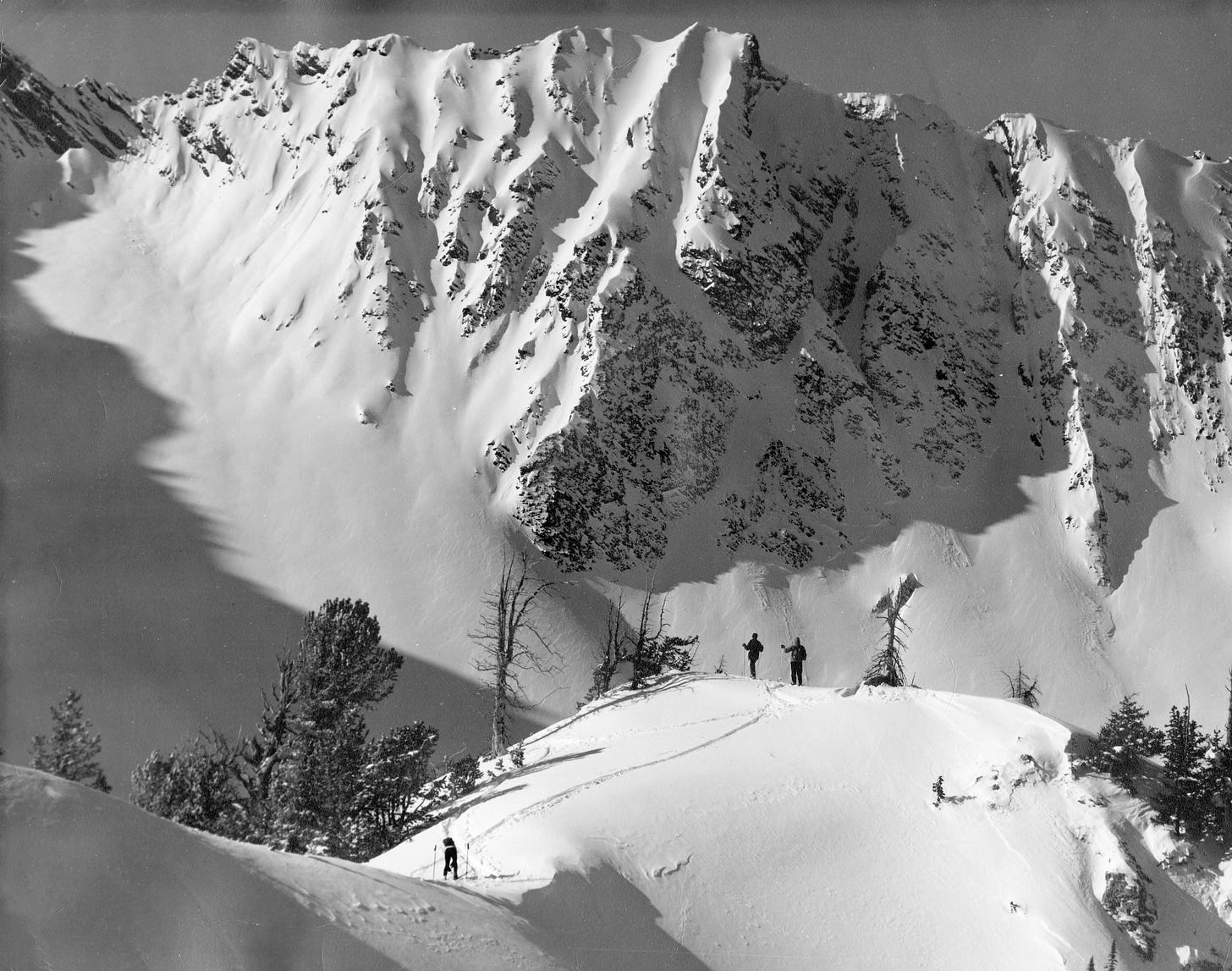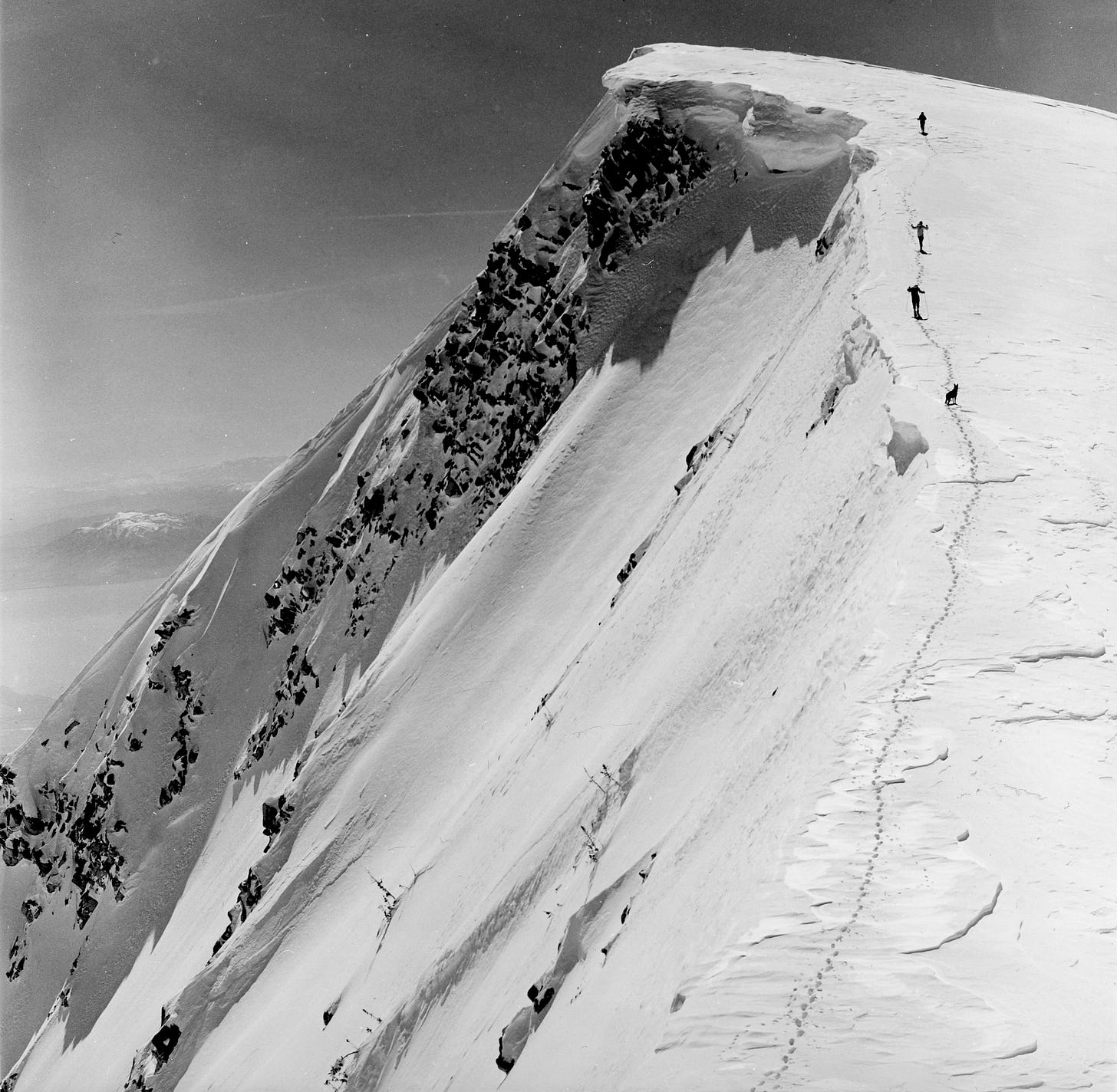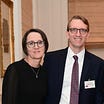Wasatch Wanderings
Alexis Kelner has been exploring the Wasatch Mountains for three-quarters of a century
A few months ago, Chris Stevenson had the chance to sit down with Alexis Kelner, a longtime member and historian of the Wasatch Mountain Club. Kelner and his family immigrated to Salt Lake City in 1950, and almost from his arrival, Kelner was active in Utah’s outdoor life. In this conversation, which has been edited for length and clarity, Kelner talks of his family’s journey from Latvia, his background in spelunking and ski tourism, and his conservationism.
All photos from the Alexis Kelner photograph collection, Marriott Library Special Collections, University of Utah
Could you talk about your growing up years a little bit?
I was born in Latvia on December 14, 1938. This is at the time when Adolf Hitler was annexing Austria. I was born in a city where my parents had an apartment house. They were fairly well off financially. The whole Kelner family, my parents and aunts and uncles, all lived in one big five-story apartment that the patriarch of the family owned.
Before Adolf Hitler invaded Russia, the Russians came in and took over Latvia. The Russians took it over in 1940, with an agreement between Hitler and Stalin that Hitler could take part of Poland, and the Russians could take part of Poland, and part of that deal was that Latvia, Estonia, and [Lithuania went to Russia]. So the Russians came in, and they really were very bad. I mean, they started to kill off the intelligentsia and convert Latvia into a communist country, and they committed a lot of atrocities against the civilian population. They would take people in the middle of the night and ship them off to Siberia.
The Russians basically arrested anyone who was a professional. It was a bad deal. In 1941, Hitler decided to move against Russia, and so part of that move against Russia was to also move into Latvia, which was now Russian territory. So we lost one dictator and gained another one. So we were under Nazi occupation from 1941 to 1944, at which point the Russians came back in and kicked Hitler out. Hitler at this time was declining in power, and the whole German Third Reich was as well, so the Russians were able to come in and retrieve Latvia and the Baltic states. They didn’t recover their freedom until 1991.
My father had been working for a German textile company in Riga, and he decided that he did not want to undergo another bout of communist control. So a lot of people in Latvia decided to move out. Some of them moved across the Baltic Sean to Sweden. So they basically gave up all of their property rights, and you had a suitcase you could take, and that was it. My family all moved to Germany, and that included going across the Polish frontier. Again, you were allowed to take one suitcase. We were on board a ship for a couple of days going between Riga and Danzig (which was part of Nazi Germany but had previously been part of Poland). So that’s how we wound up in Germany. This was 1944. By then, the war was starting to wind down because of the bombings by the British and by the Americans.
My family, when we landed from Latvia, wound up in the eastern part of Germany. There was always that threat that the Communists and the Russians would come over, so all of the people moved south towards the central part of Germany. So anyways, my family just kept moving. At that time, the only transportation that was available was the train; Germany had a very good railroad system. So we wound up living in Schöningen for a time. It’s a community between Berlin and Braunschweig, and at the time it was a center of the paint industry. The factories there were making camouflage paints for the German military.
Schöningen was a target of a lot of British bombing raids. They started bombing around 1942, 1943 for the most part. They did a lot of it—every damn community in Germany got bombed, between the British raids early on plus American bombing raids later in the war. The second place that we lived in after Schöningen was further south called Sonnenberg. That was also a small community. German cities had their factories on the perimeter, so we got bombed out there.
Do you remember these bombings?
I remember the bombings very well.
I remember that whenever the sirens sounded, the people would flock to air raid shelters. There were some tunnels nearby that were made into air raid shelters, so you would go into those things and survive the bombings.Then come back and you find that your house was no longer there, just a pile of rubble. We didn’t experience a house with rubble, but we did come back once to discover all the windows blown out. So that means a bomb probably hit nearby, and the concussion knocked out the windows.
So how did you get to Utah?
Okay, this goes back to well before the war.
The Great Depression is going on, and there’s this family in Iowa who own a slaughterhouse. And they had two or three sons and one daughter, and eventually, they all lost their jobs. And at this time, Stalin had organized a plan to industrialize Russia, and he started recruiting American workers. There was a company called Amtorg that would recruit people to go from the United States to Russia to work. Amtorg promised that salaries would be better in Russia than they had been in the United States even before the Depression. Anyways, this whole family sold their homes and they all moved to Russia.
Ultimately, they decided that they didn’t like what was going on, and they opted to return to the U.S. But the family’s nineteen-year-old son had had all of his documents stolen while in Russia, and Russia didn’t have any diplomatic relations with the U.S. So this son had to find a place nearby that could grant him the documentation to get back to the United States. So he made his way to Riga, Latvia, where he somehow made contact with my dad. My dad’s family took him in, gave him employment, gave him money, and helped him get back to the United States.
Then, during the early period after World War II, the United States passed an immigration law that allowed many thousands of people from different countries to immigrate to the U.S., so my parents decided that they would try to come to America. That entailed writing a lot of letters, because you needed a sponsor in the United States. One of these letters was sent to this Iowan who had been helped by my dad’s family.
Once he had been back in the United States for a while, this man moved from Iowa to Salt Lake City because he was an engineer for Union Pacific. And that’s where he was when my dad’s letter found him. He was living in Salt Lake on 8th West, and was a very active member of the Unitarian Church, and he got the Unitarian Church to help sponsor us. That’s the one that’s just six blocks from here.
Okay, so the Unitarian Church sponsored your family, and you came over to Utah when?
1950. I was around eleven.
So now I want to get into your interest in the outdoors in Utah. How did that come about?
Well, while we were in Germany, the only recreational activities we had in the displaced persons camp where we lived were skiing, ice skating, and volleyball. Around 1947, the U. S. Army distributed free skis to everyone, military surplus skis probably.
Okay, so how do you get from there to the Wasatch Mountain Club?
Well, my initial thing was, I was very military-oriented. I joined the Civil Air Patrol cadets, whereas everyone else was taking ROTC. I actually took ROTC in high school, because I couldn’t stand football or basketball or baseball, and ROTC was the only other alternative. I mastered the rifle and was a sharpshooter on their drill team. The Civil Air Patrol was a route to take if you wanted to join the Air Force, and I wanted to be a navigator.
So throughout junior high and high school, I was involved more in the Civil Air Patrol. There, I met a guy who was a member of the Mountain Club, and he was also a member of the Salt Lake Grotto, which was a cave exploration club.
Once I got in the Mountain Club, I discovered ski touring, rock climbing—all of those things.
So you got involved with the caving and mountain clubs as a high school student. How did that blossom into your full-blown participation in the Wasatch Mountain Club?
Yeah, well, I was involved in a cave club. We explored Neff’s Cave, which is outside of Salt Lake City. It was a very difficult cave; some kids had gotten trapped there in the early fifties. No one knew much about it, other than that it was deep. There were a couple of Mountain Club members—technical climbers—who went to the bottom. Caine Alder, who had introduced me to the Mountain and Grotto clubs, was one of those people. He decided that we needed to map the cave and determine its exact depth. He organized an expedition of six people to map the cave. I was the youngest of the group, but I was included because I knew rope handling and all of that stuff quite well.
We had a group of six people go in and rig the ropes for the first half of the cave. Then we came in the next day and used those to get down quick and then started the actual rope laying for the new stuff.
The mapping was done with a Brunton compass, which is something that miners use to map underground.
Tell us more about the Wasatch Mountain Club, how you evolved into that after you left college.
Well, I was doing chemistry at the U. I did very well in organic chemistry, which is not the case for a lot of people. In my second year, this one professor who taught the organic chemistry class suggested that I apply for a grant, an NSF senior research grant. I applied, and lo and behold, I was one of two people selected to receive this grant. I spent a whole summer doing organic chemistry research, which was delightful, because I like organic chemistry. So anyways, that also happened to be at the time I got married.;
I also continued my activities with the Wasatch Mountain Club. Eventually, I became one of the directors. We had a board of directors of around ten people or so that managed it. When I joined the Wasatch Mountain Club, our membership was about 110, because by then, the ski lifts were running and people were taking ski lifts up rather than going cross-country. I loved cross-country skiing. I think that’s part of my German Alps experience.
What was the outdoors life in Utah like then compared to now?
It was very small. I mean, the Mountain Club had between 110 and 130 people, but now it’s got about 1,500.
I became one of the directors of ski touring, and it kept growing. Part of the Wasatch Mountain Club’s regular program was a weekly ski tour, and also a weekly trip to Alta for downhill skiing. And eventually, I became good enough at skiing that Alf Engen hired me as a touring director for the Alf Engen Ski School. Engen is a big name. He’s a big name nationally and even internationally, because he was the premier ski jumper in those days. He broke many records.
How did you participate politically here, advocating for preserving wilderness areas and the outdoors broadly? I remember you came to my house once when I was a child to testify on Capitol Hill.
As part of the cave club, I got involved in conservation because a lot of the delicate caves were being looted by the locals. There were no ethics involved, not in Utah at least. Back East they had started discussing the ethics of plundering caves, and after reading about that in some of the national newsletters, I became interested in conservation.
So you did a lot of conservation of caves in Utah?
Yeah. I did some stuff. Glen Canyon Dam came into it. While I was in high school, I wrote my first conservation letter to the editor on the fact that if they keep screwing around building a Glen Canyon Dam, it’ll fill up and silt up. Go look at it now—my letter was very prescient.
The Wasatch Mountain Club has an Alexis Kelner Conservation Award. That must be reflective of all the work you did.
Yeah. That came quite a bit later. Karen Caldwell, Cal Giddings, and a lot of the older senior members that I dealt with decided to create this award for my birthday. I think it was my fiftieth birthday, and they organized this, gathered funds so that we can perpetuate it. Every year, we award somebody. Originally, it started out as an award for just club members, but we expanded it to include anyone.
Back in the early seventies, you were involved in efforts to prevent the 1976 Winter Olympics from coming to Utah. What was that about?
Denver, Colorado had just kicked them out. Denver had been granted the Winter Olympics, but there was so much financial mismanagement and manipulation of the system that the citizens of Colorado put it up for a public vote, and the voters decided that Denver should not bid. So they withdrew the bid, which was given to them by the U.S. Olympic Committee. Salt Lake City mayor Jake Garn decided that he would take advantage of that change, and he was so proud to make the announcement that Utah had been selected by the U.S. Olympics Committee to replace Denver. Well, that was the same day that we were in here, silk-screening Save Our Canyons bumper stickers.
The opposition, again, was similar to what Denver was doing, because there were a whole bunch of developers that took it over, and they were trying to ramrod it through. Eventually, they did ramrod it through, but I think we put up a reasonable fight.
You’re a pretty accomplished photographer. Do you mostly do outdoor photography
Well, that’s where I started.
I liked large-format photography. I didn’t like 35-millimeter, in fact, I threw out most of my 35-millimeter strips. It’s like the painters who throw out their early works, and I never could retrieve any of that stuff. But my 5x7 negatives, I’ve donated those to the University of Utah, and the landscapes are really very fantastic.











So interesting, thanks for sharing. I loved reading this. It made me feel that I might be taking where I live for granted.